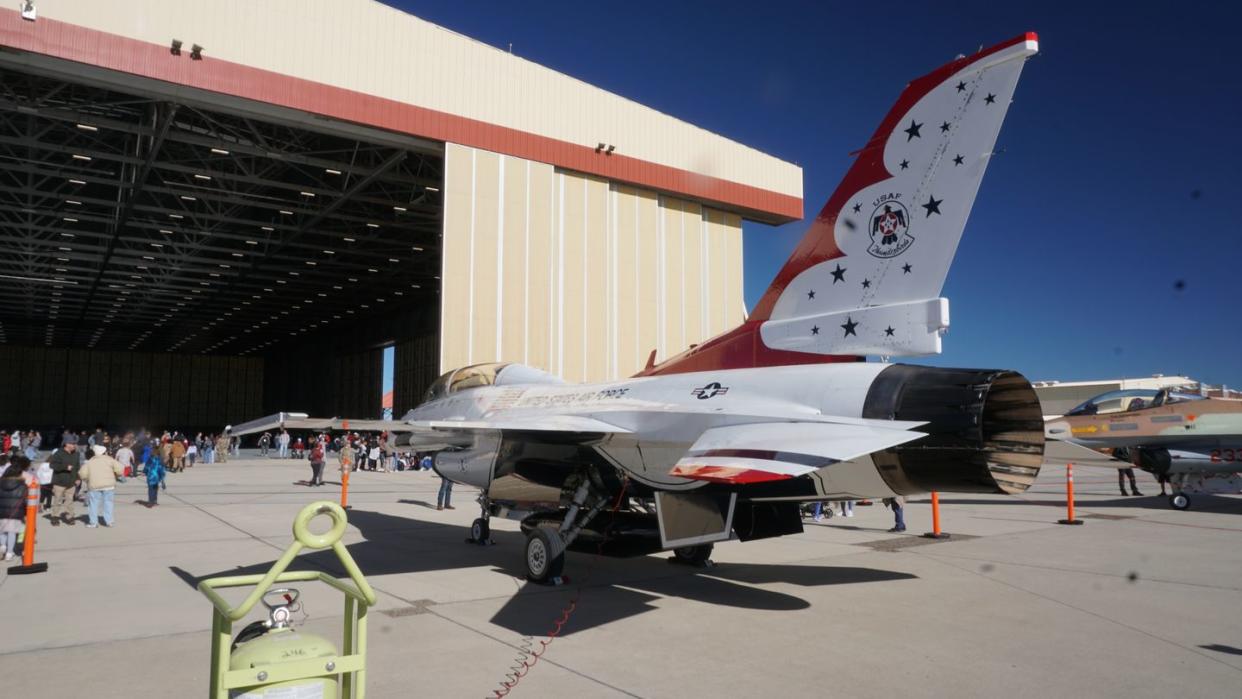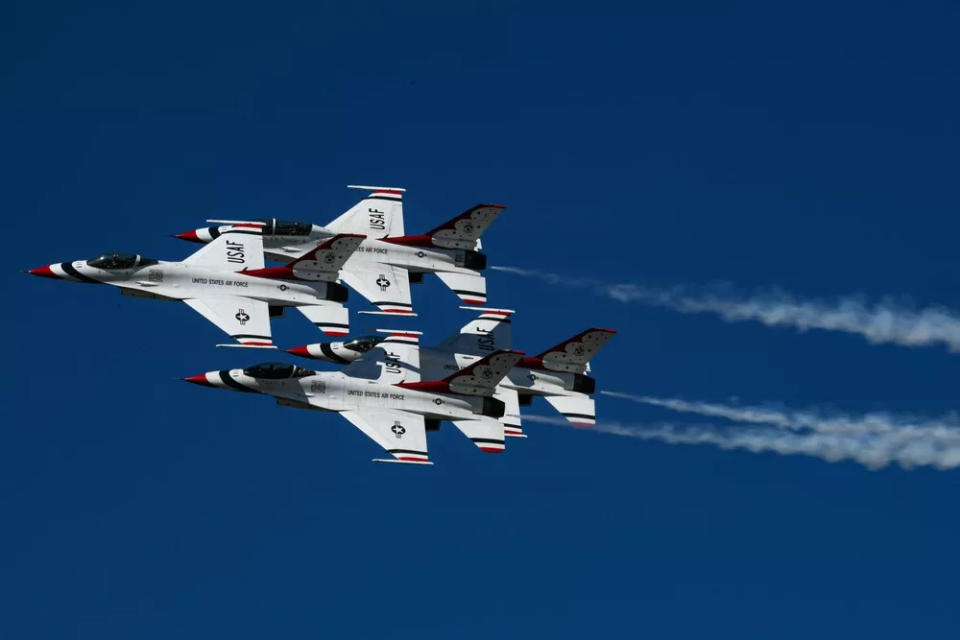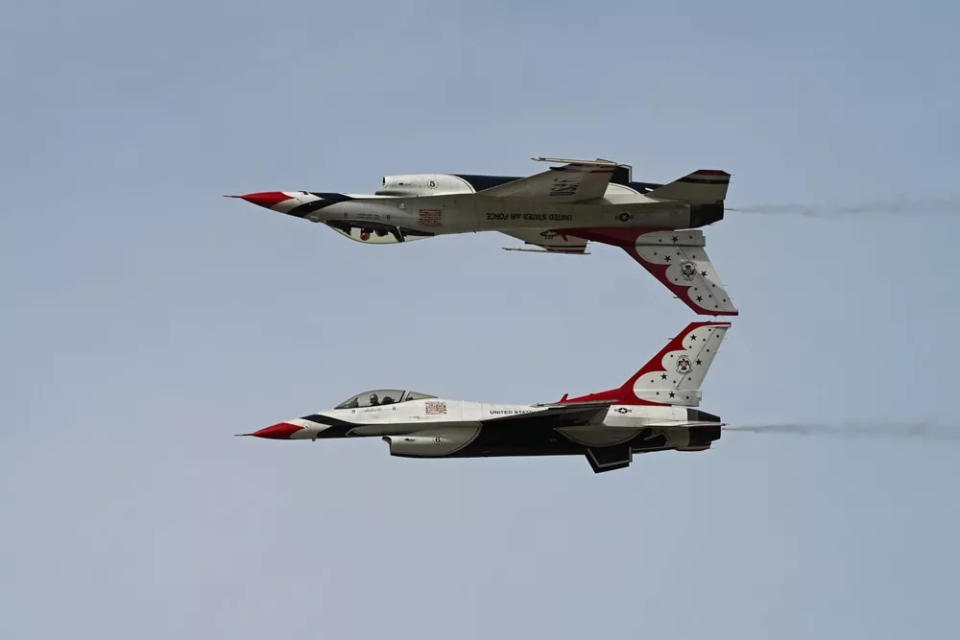F-16 Fighting Falcon Still Flying and Fighting at 50

Fifty years after it first took flight, the General Dynamics F-16 is still flying all over the world, after playing major roles in every conflict from Operation Desert Storm to NATO efforts in Bosnia and beyond.
As a fighter jet the Fighting Falcon, as it’s officially known (though all the pilots call it “The Viper”), was almost unsurpassed for generations in the skies. While the F-22 and F-35 may be able to outperform it today, the F-16 was the backbone of air superiority for half a century, with over 5000 of them still doing duty at air bases around the world, both American and allied powers.
To celebrate this milestone, the U.S. Air Force held the “F-16 First Flight 50th Anniversary Celebration” in Hangar 16 at Edwards Air Force Base in the California desert last week—and I got to go. Tallyho!
FALCON FLYBY
If you’ve never seen something like an F-16 in the air, let alone seen several of them up there at once right above you, your brain needs to be rearranged a little. I know mine was. Right after I parked my car in the parking lot just outside the hanger, as I was getting out and sort of wondering where I should go next, right then and with no warning whatsoever, the entire U.S. Air Force Thunderbirds buzzed the lot in greeting.
OMG.
Imagine this: The jet closest to me was maybe 150 feet off the ground but felt right on top of me. I could see all those titanium flaps that wrap around the afterburner, I could make out the Thunderbirds paint scheme in the shape of a bird with feathers, I could…

SKA-RAAAAMMMM-WHAM-SKREEEEM! It was upon me, over me, shaking my internal organs and hammering my ear drums, as it was for several hundred people around me who up till then had been just out walking around wondering if the local Starbucks was open when the entire might, technology, aerospace destructive force, and every screaming nut and bolt that goes into these things suddenly roared over us in one yowling and unavoidable message of modern technology at its finest.
At first you’re terrified, your monkey brain can’t grasp what’s happening. Then, just as quickly, that very same monkey realizes it will not be eaten by this thing and you instead look to the heavens and behold it in all its screaming, air-superiority glory and you raise your arms in triumph and howl as loud as you can like the primitive, howling simian you truly are.
“Woo-hoo!” you scream in one of the very few instances in our modern society (baseball home runs, roller coasters, the Lions getting into the Super Bowl) in which it is still appropriate to do so. “WOO-HOO!”
And just as quickly as it snuck up and did not kill you, the entire flight of F-16s, the epitome of a thousand years of technological advancement from the first bronze-age tool to the single 27,000-pound-thrust Pratt & Whitney/General Electric turbofan engine with which I was just bludgeoned, is gone, off over the desert somewhere else, bullseyeing womp rats in Beggar’s Canyon back home.
It is then that you hear the car alarms. Just as quickly as the F-16 Thunderbirds descended, the car alarms—hundreds of them—all started going off at once as if some mass catalytic converter theft had just been detected in thousands of parked crossover utility vehicles across every parking lot at Edwards.

Everybody in the parking lot, the same people who only seconds before had gone from the peak of monkey fear to the pinnacle of sports event jubilation, were now laughing out loud like they’d all been told the world’s funniest joke all at once. The MPs were laughing, the retired factory workers who had been invited to see the fruits of their lifetimes of labor were laughing, I was laughing. All of us howling at the transparent, hilarious absurdity of the giant emotional whoop-dee-doo through which we’d all just careened.
Ha ha, heh, heh, whooooooooo….
And that was just in the parking lot.
WHERE IT ALL STARTED
The first F-16 took its first flight way back in 1974, the result of efforts by the Department of Defense to come up with a Lightweight Fighter (LWF) to replace the heavier F-15 and the aging F-4 Phantom II and, in the fleets of our allies, all the old F-104 Starfighters and F-105 Thunderchiefs, the latter which were interceptors built to stop Soviet bombers and were never meant to act as fighter jets and had thus earned the nickname “Widowmaker” among those unlucky enough to be assigned to them.

The F-16 came about as a competition between General Dynamics (now Lockheed Martin) and McDonnell Douglas, which proposed a twin-engine, twin-tailed successor to the heavier F-14 and F-15. The Air Force liked the F-16 and the Navy liked the F-18. Everybody was happy.
“The F-16 Fighting Falcon is a compact, multi-role fighter aircraft,” the Air Force says. “It is highly maneuverable and has proven itself in air-to-air combat and air-to-surface attack. It provides a relatively low-cost, high-performance weapon system for the United States and allied nations.”
Flexible Flyer
It can handle a number of tasks.
“In an air combat role, the F-16’s maneuverability and combat radius (distance it can fly to enter air combat, stay, fight, and return) exceed that of all potential threat fighter aircraft,” the AF says.
“It can locate targets in all weather conditions and detect low flying aircraft in radar ground clutter. In an air-to-surface role, the F-16 can fly more than 500 miles, deliver its weapons with superior accuracy, defend itself against enemy aircraft, and return to its starting point. An all-weather capability allows it to accurately deliver ordnance during non-visual bombing conditions.”

At Edwards, the Air Force brought out several pilots who attested to the plane’s talents.
“The F-16 can take a decent pilot with decent skills and raise them to extremely high-performance plateaus,” said Lt. Col. (ret.) Emmett “ET” Tullia.
Combat Proven
Tulia’s story is as compelling as many when it comes to the benefits of the F-16. He flew one in Iraq, delivering a load of MK84 bombs to an oil refinery in Baghdad.
“It was day three of Desert Storm, there was an overlapping threat range from the target to 20 to 30 miles outside, there was no good, graceful way to get to and from the target area,” Tulia told a crowd of pilots, Air Force and factory retirees, and me.
“There were just way too many missiles. It was described as the most heavily defended city in the world at the time.”
Tulia didn’t know it then, but all the other F-16s in his “packet” had turned back because they couldn’t find their targets and their fuel was running low. Tulia’s electronics finally ID’d the target and down he swooped.
“We began to set up for 45 (degree) high delivery. Just as we get ready to roll in, I get an SA-2 (Soviet-made surface-to-air) missile launch warning.”
Tulia simply turned his F-16 away and avoided both SAMs. But that put him out of line to drop the bombs on the target.
“I was in no position to attack the target, it was actually in a terrible position,” he said. “So I went in anyway.”
Luckily, among the F-16’s phalanx of electronic warfare technology included something called a CCIP, continuously calculated impact point. But even with that, his plane was way off line for the target.

“Fortunately, I’m not that good of a pilot and I’ve seen that before. So I made a huge correction.”
He knew he had to hit the refinery perfectly because it was surrounded by civilians. He hit it dead center.
“It was big fireball, huge and getting bigger. It was just astounding. And let me stop for a second and say the local newspaper, The Gulf Times, covered the whole Middle East, did a newspaper article on that strike a couple days later, and they specifically praised ‘...that skilled American pilot who destroyed the target and didn’t hit any civilians.”
He still smiles when he recalls that.
On the way back he evaded two more SA-2s and then ran out of gas just as he landed on the runway at Doha, Qatar.
“So, the engineers who built that thing, my hat’s off to you.”
There were other pilots, other stories, all praising the F-16 and its remarkable abilities. At one point during the day, just outside Hangar 1600, a mighty black F-35 rolled past, the current Big Jet on Campus, the successor, the New Kid In Town. It was big, with a reptilian black pattern all over it and a single giant jet running down its middle. It was surely more effective than the F-16, could surely do more and do it better. But the F-16 did it well for 50 years, and for that the Air Force was saluting it and the men and women who flew it and the ground crews that kept it flying. The U.S. Air Force stopped ordering new F-16s a few years ago, though certain allies still order them.
Is it a thing of beauty? Lt. Col. (Ret.) Jeff “Tico” Tice flew F-16s for 20 years, but still remembers the first time he saw one.
“I was a freshman in college and I saw that airplane and when it landed and they took that side view. It just stole my heart. It's your first love. You never forget it. And the old fighter-pilot cliché, ‘If it looks good it’s going to fly good,’ ladies and gentlemen, that airplane still looks good after 50 years.
Then, because he’s an Air Force fighter pilot, Tico had to add, “Kind of like me.”
Off we go.

